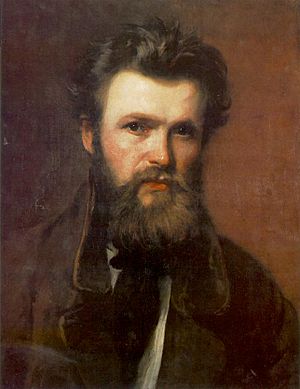Miklós Izsó facts for kids
Quick facts for kids
Miklós Izsó
|
|
|---|---|
| Izsó Miklós | |

Portrait of Miklós Izsó
by Bertalan Székely |
|
| Born | September 9, 1831 Disznós-Horvát
|
| Died | May 29, 1875 (aged 43) Budapest
|
| Nationality | Hungarian |
| Known for | Sculptor |
| Style | Classicism and academic |
Miklós Izsó (born September 9, 1831, died May 29, 1875) was a famous Hungarian sculptor. He is known for creating beautiful statues that blended two main art styles: classicism and academic style. Classicism means his art often looked back to ancient Greek and Roman art, focusing on balance and ideal forms. Academic style means he followed traditional rules and techniques taught in art schools.
Izsó's sculptures often showed Hungarian life and history. He helped shape Hungarian art during his time. His work is still admired today for its skill and feeling.
Contents
Who Was Miklós Izsó?
Miklós Izsó was a talented artist from Hungary. He became one of the most important sculptors of his time. His art helped to show the spirit and culture of Hungary. He created many well-known statues. These statues are still important parts of Hungarian art history.
Early Life and Artistic Beginnings
Miklós Izsó was born in a small village called Disznós-Horvát. This village is now known as Izsófalva. It is located in northeastern Hungary. From a young age, Izsó showed a talent for art. He was especially good at shaping things. This early interest led him towards sculpture.
His early life was shaped by the times he lived in. He grew up during a period of big changes in Hungary. These changes later influenced his art.
A Patriot and Artist
Izsó was not just an artist; he was also a patriot. He cared deeply about his country. In 1848, a significant event happened in Hungary. This was the Hungarian Revolution of 1848. It was a fight for Hungary's independence. Young Miklós Izsó took part in this movement.
His experiences during this time influenced his artistic vision. He often created sculptures that celebrated Hungarian heroes. He also depicted scenes from Hungarian folk life. This showed his love for his homeland.
Education and Artistic Journey
After the revolution, Izsó continued his art studies. He traveled to Vienna, Austria. There, he attended the Academy of Fine Arts Vienna. This was a very famous art school. He learned many new techniques there. He studied the human form and how to create realistic sculptures.
Later, he also spent time studying in Germany. These experiences abroad helped him grow as an artist. He learned from different art traditions. He brought these new ideas back to Hungary.
His Artistic Style
Miklós Izsó's sculptures are easy to recognize. They combine two main styles. One is classicism. This means his figures often look strong and balanced. They remind people of ancient Greek statues. The other style is academic. This means he followed strict rules of art. He paid close attention to details.
He was also known for his ability to capture emotion. His statues often show feelings. They tell a story through their poses and expressions. He often created figures of ordinary people. He also sculpted famous Hungarian figures.
Important Works and Legacy
Izsó created many famous sculptures. One of his most well-known works is "The Dancing Shepherd." This statue shows a lively shepherd. It captures movement and joy. It is a great example of his skill.
Another important work is the statue of Sándor Petőfi. Petőfi was a famous Hungarian poet. Izsó's statue honored this national hero. His works are displayed in museums. They can also be found in public spaces in Hungary. His art helped to create a national style of sculpture.
Later Life and Passing
Miklós Izsó's life was dedicated to art. He continued to create sculptures until his death. Sadly, he passed away at a young age. He died in Budapest in 1875. He was only 43 years old. His death was caused by tuberculosis.
Despite his short life, Izsó left a lasting mark. His sculptures continue to inspire. They are a valuable part of Hungarian cultural heritage. He is remembered as a pioneering Hungarian sculptor.

